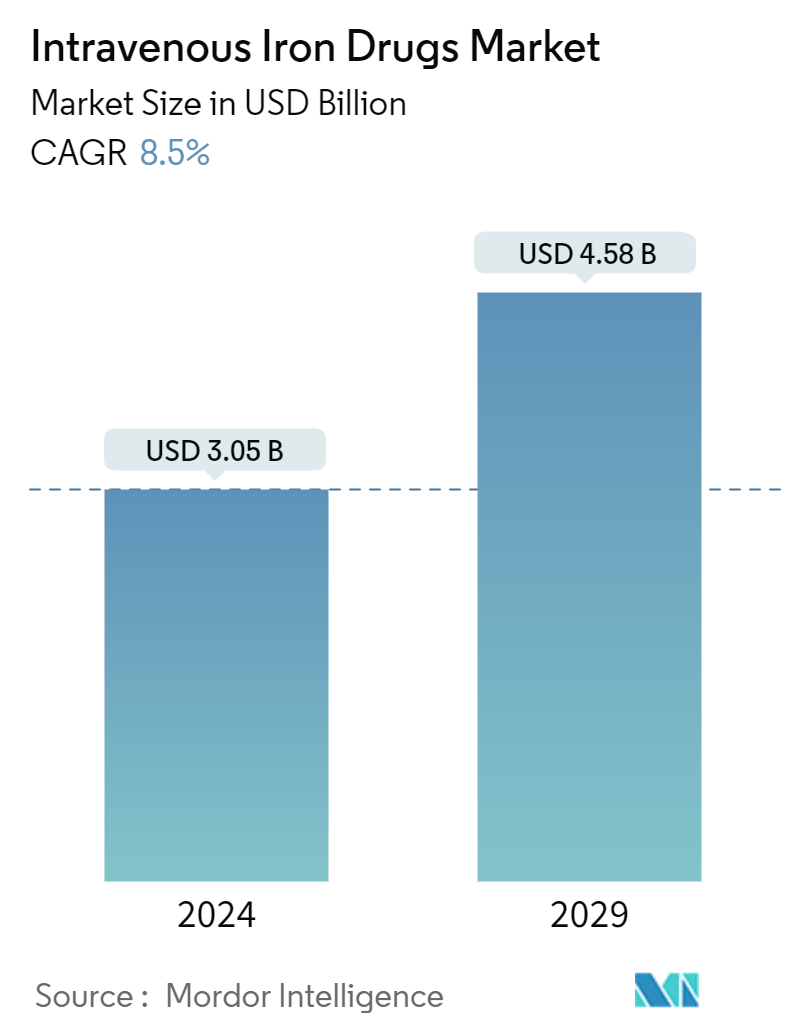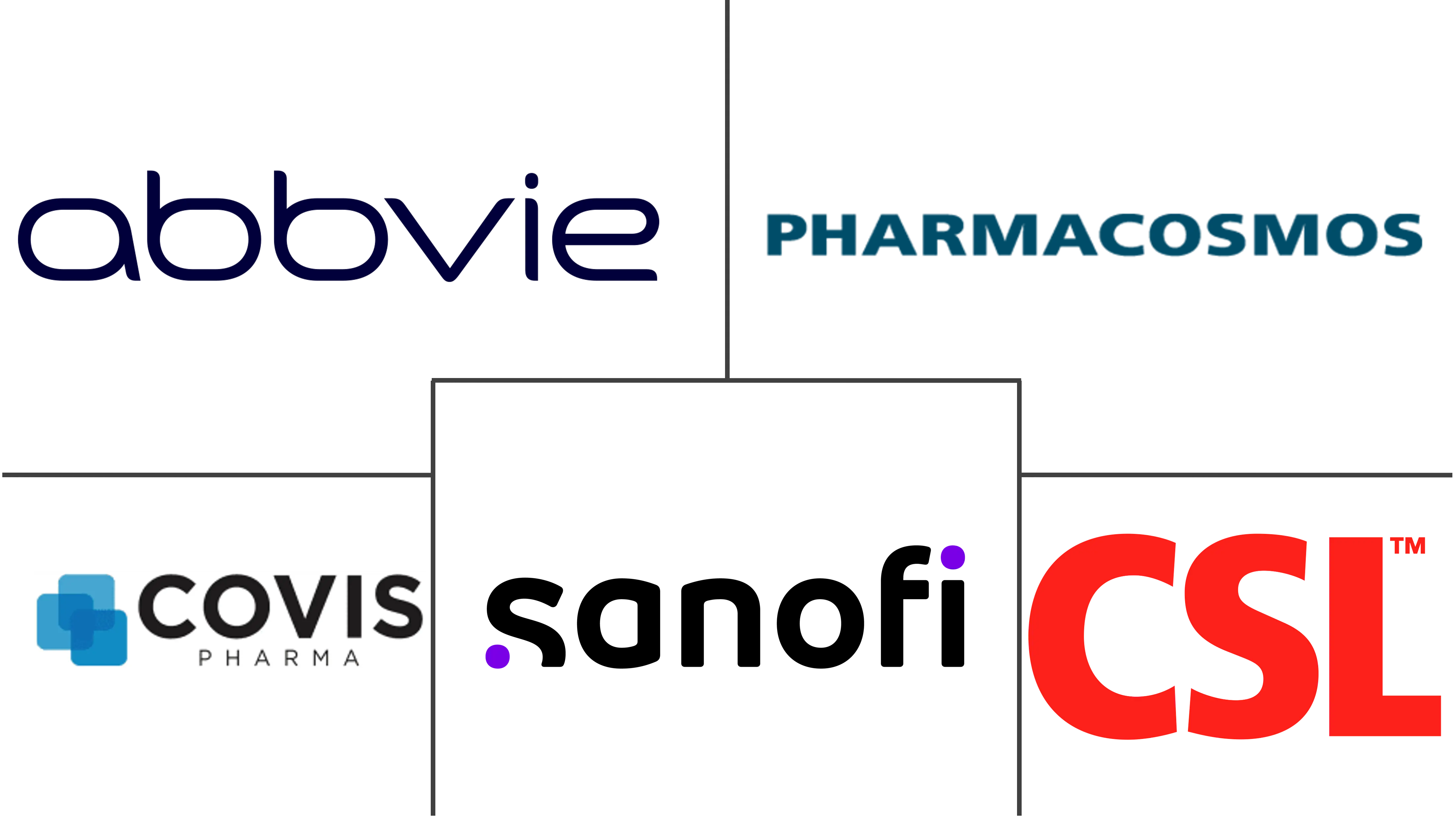Market Size of Intravenous Iron Drugs Industry

| Study Period | 2019 - 2029 |
| Market Size (2024) | USD 3.05 Billion |
| Market Size (2029) | USD 4.58 Billion |
| CAGR (2024 - 2029) | 8.50 % |
| Fastest Growing Market | Asia-Pacific |
| Largest Market | North America |
Major Players
*Disclaimer: Major Players sorted in no particular order |
Intravenous Iron Drugs Market Analysis
The Intravenous Iron Drugs Market size is estimated at USD 3.05 billion in 2024, and is expected to reach USD 4.58 billion by 2029, growing at a CAGR of 8.5% during the forecast period (2024-2029).
During the pandemic, there is a slight decline in the intravenous iron drugs market due to the disruption of the supply chain and manufacturing process. But the market recovered soon and has grown subsequently, as there was a high demand for intravenous iron drugs, due to the increased risk of chronic kidney failure (CKD)-related anemia in COVID-19 patients. Furthermore, as per the article published by PubMed in August 2021, an older patient with numerous concomitant conditions who was hospitalized for COVID-19 was treated for iron deficient anemia with ferric carboxymaltose (Ferinjectâ, Vifor International). The medication caused the hemoglobin (Hb) to return to normal, the iron reserves to quickly restock, and the transferrin saturation to simultaneously improve. In cases of severe patients with diffuse coagulopathy, like the one in the present case, ferric carboxymaltose can be thought of as a viable option to treat anemia while a patient is being treated in a hospital for COVID-19 and avoid transfusion regimens. Hence as per the facts mentioned above, COVID-19 had a significant impact on the intravenous iron drugs market. However, as the pandemic has subsided, the studied the market is expected to have a stable growth during the forecast period of the study.
Certain factors driving the market growth include the increasing prevalence of target diseases such as chronic kidney disease-related anemia, irritable bowel syndrome, cancer-related anemia, disadvantages of oral iron drugs, and an increasingly aging population. For instance, as per the article published by PubMed in July 2022, a study was conducted which showed that IV iron for the treatment of cancer-induced anemia (CIA) reduces the need for red blood cells (RBC) transfusions and is not associated with adverse events. IV iron for the treatment of cancer-induced anemia should be considered in clinical practice.
Furthermore, government initiatives, research, and development in the field of IV iron drugs and the presence of competitors boost the market growth. For instance, in February 2021, The National Medical Products Administration (NMPA) in China approved Monofer (Ferric Derisomaltose) injection 100 mg/mL developed by Pharmacosmos. Monofer is an intravenous iron that is used in adult patients who have an intolerance to oral iron or unsatisfactory response to oral iron, or when there is a clinical need to administer iron quickly.
Apart from this, iron deficiency anemia is another common consequence of inflammatory bowel disease (IBD). For instance, according to an article published by PubMed Central in November 2022, iron deficiency (ID) and anemia in patients with inflammatory bowel disease (IBD) is often associated with a reduced quality of life. The article also stated that a study was conducted among a few IBD patients in the Netherlands, and it was found that the overall prevalence of anemia, iron deficiency and iron deficiency anemia was 18.0%, 43.4%, and 12.2%, respectively. Intravenous iron drugs are preferred for the treatment of IBD associated with iron deficiency anemia. Oral iron supplementation is the most frequent iron-deficient anemia treatment; however, it has been linked to gastro intestinal (GI) side effects such as constipation and bloating. Due to the lack of exposure to the intestinal lumen, intravenous iron drugs do not elicit gastro intestinal adverse effects. Therefore, chronic diseases such as CKD and IBD have resulted in persistent and prolonged anemia, fueling the growth of the intravenous iron drugs market.
Hence, due to the factors mentioned above such as the government initiatives, research, and development in the field of IV iron drugs, and increasing effectivity of IV iron drugs in cancer related anemia and irritable bowel disease, the studied market is anticipated to grow over the forecast period. However, adverse reactions associated with intravenous iron drugs restrain the market growth.
Intravenous Iron Drugs Industry Segmentation
As per the scope of the report, intravenous iron drugs are iron supplement that is given through the intravenous route to compensate for iron losses in the blood in a certain clinical condition such as Chronic Kidney Disease (CKD), Intestinal Bowel Disease (IBD), cancer, among others to treat iron deficiency anemia. Intravenous iron drugs play a key role in treating diseases in nephrology, gastroenterology, oncology, critical care, gynecology, and others. The intravenous iron drugs market is segmented by Product Type (Ferric Carboxy maltose, Iron Sucrose, Iron Dextran, and Others), Applications (Chronic Kidney Disease, Irritable Bowel Syndrome, Cancer, and Others), and Geography (North America, Europe, Asia-Pacific, Middle East and Africa, and South America). The market report also covers the estimated market sizes and trends for 17 different countries across major regions, globally. The report offers the value (in USD million) for the above segments.
| By Product Type | |
| Ferric Carboxymaltose | |
| Iron Sucrose | |
| Iron Dextran | |
| Others |
| By Application | |
| Chronic Kidney Disease | |
| Irriable Bowel Disease | |
| Cancer | |
| Others |
| Geography | ||||||||
| ||||||||
| ||||||||
| ||||||||
| ||||||||
|
Intravenous Iron Drugs Market Size Summary
The intravenous iron drugs market is poised for substantial growth, driven by the increasing prevalence of chronic conditions such as chronic kidney disease (CKD) and inflammatory bowel disease (IBD), which often lead to iron deficiency anemia. The market experienced a temporary setback during the pandemic due to supply chain disruptions but quickly rebounded as the demand for intravenous iron drugs surged, particularly for treating anemia in COVID-19 patients. The effectiveness of intravenous iron therapies, such as ferric carboxymaltose, in managing anemia related to these conditions has been well-documented, supporting their continued use and adoption in clinical practice. Government initiatives and ongoing research and development efforts further bolster market expansion, with new product approvals and launches enhancing treatment options for patients intolerant to oral iron or requiring rapid iron replenishment.
The North American region dominates the intravenous iron drugs market, attributed to the high prevalence of CKD and gastrointestinal illnesses like IBD, which necessitate the use of these therapies. The market is characterized by a few key players holding significant shares, with companies like CSL Limited, AbbVie, and Pharmacosmos leading the charge. The introduction of new intravenous iron formulations, such as Ferumoxytol Injection, and the ongoing clinical studies to explore their efficacy in various patient populations, including postpartum women, are expected to drive further growth. Despite the promising outlook, the market faces challenges from potential adverse reactions associated with intravenous iron drugs, which could impede growth. Nonetheless, the overall trajectory remains positive, with increasing awareness and acceptance of these therapies in managing iron deficiency anemia across different patient demographics.
Intravenous Iron Drugs Market Size - Table of Contents
-
1. MARKET DYNAMICS
-
1.1 Market Overview
-
1.2 Market Drivers
-
1.2.1 Increasing Prevalence of Target Diseases
-
1.2.2 Disadvantages of Oral Iron Drugs
-
-
1.3 Market Restraints
-
1.3.1 Adverse Reactions associated with Intravenous Iron Drugs
-
-
1.4 Porter's Five Force Analysis
-
1.4.1 Threat of New Entrants
-
1.4.2 Bargaining Power of Buyers/Consumers
-
1.4.3 Bargaining Power of Suppliers
-
1.4.4 Threat of Substitute Products
-
1.4.5 Intensity of Competitive Rivalry
-
-
-
2. MARKET SEGMENTATION (Market Size by Value - USD Million)
-
2.1 By Product Type
-
2.1.1 Ferric Carboxymaltose
-
2.1.2 Iron Sucrose
-
2.1.3 Iron Dextran
-
2.1.4 Others
-
-
2.2 By Application
-
2.2.1 Chronic Kidney Disease
-
2.2.2 Irriable Bowel Disease
-
2.2.3 Cancer
-
2.2.4 Others
-
-
2.3 Geography
-
2.3.1 North America
-
2.3.1.1 United States
-
2.3.1.2 Canada
-
2.3.1.3 Mexico
-
-
2.3.2 Europe
-
2.3.2.1 Germany
-
2.3.2.2 United Kingdom
-
2.3.2.3 France
-
2.3.2.4 Italy
-
2.3.2.5 Spain
-
2.3.2.6 Rest of Europe
-
-
2.3.3 Asia-Pacific
-
2.3.3.1 China
-
2.3.3.2 Japan
-
2.3.3.3 India
-
2.3.3.4 Australia
-
2.3.3.5 South Korea
-
2.3.3.6 Rest of Asia-Pacific
-
-
2.3.4 Middle East and Africa
-
2.3.4.1 GCC
-
2.3.4.2 South Africa
-
2.3.4.3 Rest of Middle East and Africa
-
-
2.3.5 South America
-
2.3.5.1 Brazil
-
2.3.5.2 Argentina
-
2.3.5.3 Rest of South America
-
-
-
Intravenous Iron Drugs Market Size FAQs
How big is the Intravenous Iron Drugs Market?
The Intravenous Iron Drugs Market size is expected to reach USD 3.05 billion in 2024 and grow at a CAGR of 8.5% to reach USD 4.58 billion by 2029.
What is the current Intravenous Iron Drugs Market size?
In 2024, the Intravenous Iron Drugs Market size is expected to reach USD 3.05 billion.

